The Bagpipe Society
What’s in a name
You may remember in the Winter 2014 Chanter, I reported that there was an online petition to protest about the proposed change of name to the Boha. At the IBO Conference Yan Cozian and Jean Michel Espinasse explained the background to the issue and below is an abbreviation of their talk. — Editor.
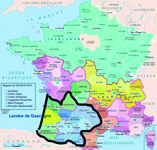
The word, boha, is an Occitan word, which comes from the verb “to blow”. The boha historically was played in a part of the south west of France: les landes de Gascogne. This part of this territory is well identified, as there is a Natural Regional Park in the landes de Gascogne. This bagpipe has an organology that is completely different from the other bagpipes in France. The main characteristics of the boha are:
- a bag
- a blowpipe
- a pihet with 2 pipes each of them using a simple reed, one is for the melody, the other one has only one sounding hole.
- a brunider is added to it. The brunider is a piece of wood which modifies the note according to its position.
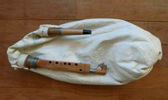
At the beginning of the nineties to adapt the instrument to his musician needs Alain CADEILLAN made a hole for the seventh note of the scale. Further changes and adaptations to the original instrument were made by Robert Matta in the nineties and then again in 2000 by the association of Cozian-Saintorens highly spread this model under the name boha. Previous articles in Chanter have explored these developments. So, is the instrument of today an evolution or an invention?

For me, these modifications are an evolution as they don’t change the basic characteristics of the boha as quoted before. However, other people think that these transformations create a new instrument different from the bagpipe of the landes de Gascogne.
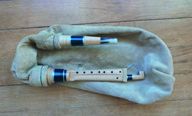
This controversy would have remained completely conceptual had it not been for the action taken by the Bohaires de Gasconha (BDG), an association of musicians and makers, in 2015. Using the vehicle of the Intangible Cultural Heritage they lodged a motion to modify the French name : Cornemuse de Gascogne and thus eradicating the historical homeland of “landes” in the name. Not everyone agreed with this proposed change which led to various protests. The case was not helped by the fact that the Intangible Cultural Heritage was accepted by the French government, thus giving an institutional authentication to the change of its name.
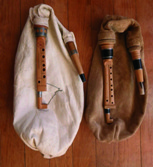
Several reasons were put forward by BDG to justify this change of name:
- the boha today is completely different from, and has nothing to do with boha of the past
- the boha is now played throughout Gascony, not just the landes, and elsewhere outside of the region.
The first reason given by BDG association
The boha today is completely different (has nothing to do, as they say) from the boha of the past.
Their arguments were:
- New playing holes have been made.
- New tones have been created
- Bags and reeds are made of synthetic materials
Those points do not stand as all instruments follow evolution and their names are not changed! For example, the Great Highland bagpipe now has gore tex bags and carbon reeds. Likewise in France, the musette from central France now has an extra hole, for the thumb of the right hand and a key has been added on some models. The reeds are now often made of synthetic material - but nobody wants to change its name from the musette.
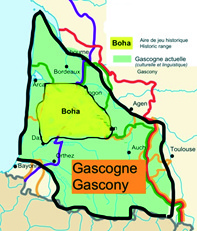
The second reason
Now we play the boha everywhere in Gascony, even outside this territory
The BDG argue that as the number of players of boha exceeds the historical territory, the name of the instrument should be changed. This is nonsense and contrary to ethics and to scientific orientation. If this behaviour is accepted, we could imagine it to be used for other places and other bagpipes. Let’s imagine that the Great Highland bagpipe is played in India, in the States, in Australia, … in England, should an association ask to change its name and call it a Commonwealth bagpipe or World bagpipe?! If changing the name of the boha is justified because it’s played all over the Gascony and even farther, we can indeed think that it will have to change its name again due to its establishment in other neighbouring departments. With such arguments we could fear an association calls it again a bagpipe from the south west!! 7
It’s easy to understand how stupid this argument is. We can’t deprive an instrument of its history and historical territory without cutting it from its roots and legitimacy. Moreover what is more surprising is the French government’s acceptance to change the name in one language and not in another. In the South west of France there are 2 languages French and Gascon. If we can’t use the French name bagpipe from landes de Gascogne why do we have to use boha in Gascon language????? If an instrument has to change its name in one country, should not it change its name in all the other languages that exist in this country?
To be more precise and closer to reality we should ask these questions to ourselves:
- Who is the owner of the history of the practice of an ethnic music instrument
- Who is the owner of an intangible heritage? The musicians? The inhabitants of the territory? The ethnomusicians ?
Over 400 people have signed the petition protesting against the change of name, and it has aroused a lot of support — from the inhabitants of the territory, the president of the regional park of the lande de Gascogne who has the greatest number of old bohas. The president of the Landes department, MP’s have even written to the government department questioning the motives behind the Intangible Cultural Heritage. That’s why I wanted to alert the international bagpipe community and to talk to you about it. Is making 2 new playing holes or using synthetic reeds an evolution or the invention of a new instrument?? I’ll let you answer this question.
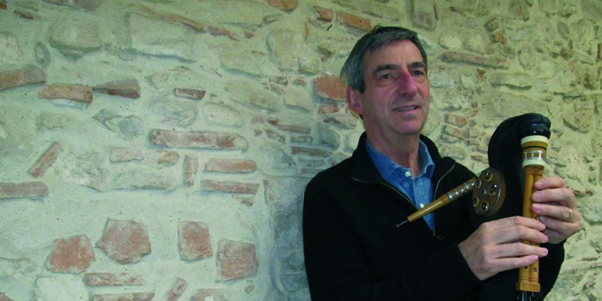
As an update to the article, on the 19 April the following was announced in news service, Sud Ouest, by reporter Isabelle Chambon.
The boha has retained its original name. The outcome of this case was unexpected and the action fought by Yan Cozian has just been concluded in a very satisfactory way. It attracted many sympathetic views. Everything was triggered by the application of an entry in the Intangible Cultural Heritage of Unesco by Bohaires of Gasconha but under the name of “Gascogne bagpipe.” The Ministry of Culture has finally updated the profile of the instrument on its website, taking the name “bagpipe Landes de Gascogne”. Yan Cozian talks about the action that enabled this change.
Sud Ouest: “What was your reaction when you saw the boha was named “bagpipe Gascogne”?”
Yan Cozian: “We sought dialogue but were ignored. An online petition was launched and collected over 400 signatures. We held public meetings with which attracted not only supporters but the curious. People were taken and moved and moved by the issue. This was collective action. The involvement of musicians, learned societies, dancers, singers, practictioners of local traditions, elected officials and media was also very important. Above all, this collective action was relayed by people tied to the history of their land, people gathered around deeply rooted heritage. It’s a country that has risen! It was recognized in this instrument that we interact. Identity is important: “We need to know where we come to know where you are going.” It relates to the current malaise with the shifting of traditions … It is an instrument that is not static and is constantly evolving.
How did we come to this happy outcome? We took various actions to increase awareness of the heritage of the boha. We met with elected community, elected representatives of the Department of Culture Committee and the Regional Councillors. All were very attentive. Once they had the matter in hand, the Department’s policies and, I think, in the Region responded very quickly. And eventually unlocked the very strong consensus around the instrument.
What conclusion can we draw from this episode and what future for our Landes bagpipes?
People have fallen in love with this instrument. This “collective” has become very important, beyond what I could have imagined. This action allowed us to discover, to have confidence in each other, a brotherhood was created. Our will is appeasement is working together again with all bohaires, enthusiastically and without hostility.”
The boha is now formally recognised as the “bagpipe of the Landes de Gascogne”.
- Data Processing Notice (GDPR)
-
@BagpipeSociety on X (formally known as Twitter)
-
TheBagpipeSociety on Instagram
-
 BagpipeSociety on Facebook
BagpipeSociety on Facebook
Something wrong or missing from this page? Let us know!
